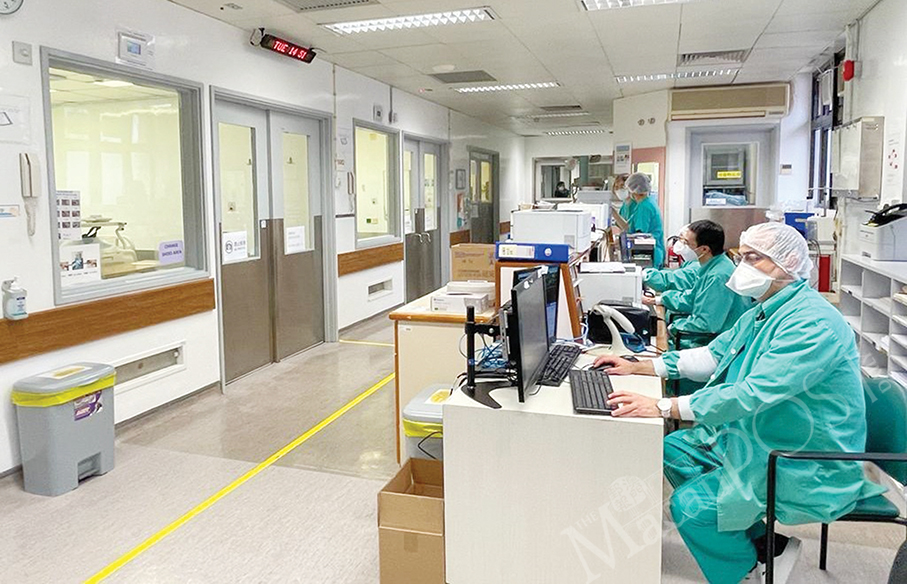Macau’s daily number of new COVID-19 patients admitted to the Health Bureau’s (SSM) isolation and treatment facilities continues to be on the decline, recent and yesterday’s official figures indicated.
Official figures released yesterday showed that 17 new COVID-19 patients were admitted to the facilities on Tuesday. Recent official figures showed that the new daily number of COVID-19 patients admitted to the isolation and treatment facilities began to decline over last weekend.
From Friday to Monday, according to previous government statements, the new daily numbers of patients admitted to the isolation and treatment facilities after having been diagnosed with the novel coronavirus disease were 107, 77, 52, and 26 respectively.
Macau’s highest daily number of new COVID-19 patients admitted to the isolation and treatment facilities stood at 145 on December 29, following the local government’s decision to abandon its long-running dynamic zero-COVID approach early last month.
Since December 29, the new daily number of patients admitted has generally been on a declining trend, with minor fluctuations, sometimes higher and sometimes lower. Specifically, from December 30 to Thursday last week, according to official figures at that time, the new daily numbers of patients admitted to the Health Bureau’s isolation and treatment facilities after having been diagnosed with the novel coronavirus disease were 124, 114, 78, 110, 104, 102, and 89 respectively.
The Health Bureau’s isolation and treatment facilities currently comprise the public Conde de São Januário Hospital Centre, the Public Health Clinical Centre in Coloane, and hotels used for isolation treatment.
According to the Health Bureau’s COVID-19 website, which was updated yesterday, Macau’s official cumulative number of confirmed COVID-19 cases stood at 3,377, of which 3,079 had meanwhile been cured.
The Health Bureau said last week that Macau’s first peak of new daily serious cases had begun to decline at that time, following the local government’s decision to abandon its long-running dynamic zero-COVID approach early last month.
The number of the 17 new COVID-19 patients admitted to the isolation and treatment facilities on Tuesday was announced in a Novel Coronavirus Response and Coordination Centre statement yesterday.
4 more COVID-19 fatalities, raising official death toll to 95
Yesterday’s statement by the centre also announced that four more people died of the novel coronavirus disease on Tuesday, raising Macau’s official COVID-19 death toll to 95.
According to the statement, the four victims, three males and one female, aged between 81 and 93, had all suffered from underlying diseases.
Only one of them had not been vaccinated against the novel coronavirus, or 25 percent, the statement said.
Macau’s highest daily number of new COVID-19 fatalities stood at nine on Thursday last week. Since then, the new daily number of COVID-19 fatalities also appears to be trending down. From Friday to Monday, according to previous statements by the centre, the new daily numbers of COVID-19 fatalities were six, five, six, and two respectively.
Macau’s first six COVID-19 fatalities were reported during Macau’s previous COVID-19 outbreak that began on June 18 last year and started to subside in late July, colloquially known as 618 outbreak in Cantonese. The Macau government was pursuing a dynamic zero-COVID approach when the city was hit by the 618 outbreak.
Macau’s seventh COVID-19 fatality was reported on December 13, a few days after the Macau government switched to an adjusted anti-COVID-19 approach that implicitly allows constant transmissions of the novel coronavirus in the community.
Vulnerable groups more likely reinfected in near future
The Macau government ended the city’s transition period tackling COVID-19 on Sunday, which began on December 8 when it commenced its gradual easing of COVID-19 curbs.
The government has said that COVID-19 has now become an endemic disease in Macau following the termination of an anti-COVID-19 transition period.
The Health Bureau has said that in the new landscape where COVID-19 is now endemic in Macau, the novel coronavirus will constantly exist and spread in the community, meaning that the city is expected to continue to be affected by the periodic occurrence of relatively small-scale peaks in the foreseeable future, like elsewhere in the world.
The Health Bureau said last week it estimated that up to 70 percent of the population had already been infected with COVID-19 at that time, adding that the situation has resulted in a relatively high level of immunity against COVID-19 in the population in general for three to six months. Despite this situation, the bureau warned last week that vulnerable groups, such as senior citizens, those with chronic diseases, those with a weak immune system, and unvaccinated individuals, would be more likely reinfected with COVID-19 even in the near future.
Health codes needed for certain people
Since Sunday, when the Macau Health Code ceased its red and yellow codes, people in Macau have no longer been required to report their state of health by generating their Macau Health Code when entering any public venues in the city. Nevertheless, the Health Bureau has indicated that for the time being the Macau Health Code is still needed for those who are required to display their negative COVID-19 nucleic acid test (NAT) or rapid antigen test (RAT) result, such as those entering Macau from foreign countries. In addition, school students and teachers are currently required to display a negative RAT result every day when entering their schools, except those who have been infected with COVID-19 after November 28.
Since Sunday, people in Macau have no longer been able to obtain a government-issued e-certificate proving that they have been infected with COVID-19. During the city’s anti-COVID-19 transition period which began last month and ended on Sunday, people in Macau were able to obtain such a certificate by reporting that they had tested positive for COVID-19 on the Health Bureau’s e-platform. People who were unable to work after having been infected with COVID-19 could use it as a sick-leave certificate submitted to their employers during the transition period.

Healthcare professionals work at the area of intensive care units (ICUs) for COVID-19 patients at the public Conde de São Januário Hospital Centre earlier this week.
– Photo courtesy of TDM






